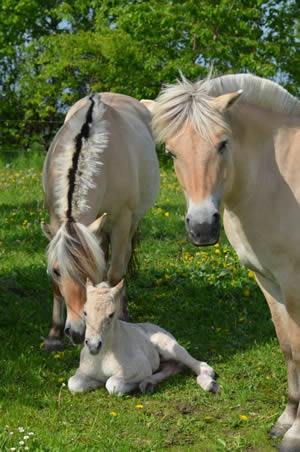General Description
The Registry maintains a stud book for Fjords in America to keep accurate bloodlines. Rules of Registration are designed to preserve genetic purity and type.
Working with Norway, the Registry serves to promote the Fjord horse and provide educational information to those interested in Fjords. A list of breeders all over America is available through the Registry. The Registry keeps statistics on the Fjord horse in America and also offers a judges training program in cooperation with Norway.
The Registry stives to promote good horsemanship and breeding practices among members. Excellence in performance in recognized through award programs.
One of the Norwegian Fjord Horse's most unique characteristics is that approximately 90 percent of all Fjord horses are brown dun in color. The other 10 percent are either red dun, gray, pale dun, gold or yellow dun. The Fjord horse retains the "wild" dun color of the original horse as well as the primitive markings which include zebra stripes on the legs and a dorsal stripe that runs from the forelock down the neck and back and into the tail. Dark stripes may also be seen over the withers. Red duns have reddish-brown stripes and body markings. Gray duns have black or very dark gray stripes and markings. The pale or white dun is a very light body color with black or gray stripe and markings. The yellow dun have a darker yellow stripe and markings, they may have a completely white forelock, mane and tail. The yellow dun is a very rare color in the breed.
Another unique characteristic of the Fjord horse is the mane. The center hair of the mane is dark (usually black) while the outer hair is white. The mane is cut short so it will stand erect. It is trimmed in a characteristic crescent shape to emphasize the graceful curve of the neck The white outer hair is then trimmed slightly shorter than the dark inner hair to display the dramatic dark stripe.
The head and neck should present an appearance of elegance without coarseness. The head is medium sized and well defined with a broad, flat forehead and a straight or slightly dished face.
The eyes are large. The ears are of small to medium size and set well apart. The neck of the Fjord horse is well muscled and crested. It has lower withers than many breeds. While defined, the withers are generally level and strongly muscled. The Fjord horse has a compact body with a deep girth and well sprung ribs. The back is short to medium in length with a strong coupling. The loin is broad and strong. The croup is well muscled and well rounded to the tail. The legs are powerful, with substantial bone and excellent feet which are black in color.
Used for draft work, riding, and driving, individuals vary in size and weight according to use. Although there is no true distinction, references are often made to a "riding" versus a "draft" type of Fjord, depending upon the characteristics emphasized. The Fjord horse ranges in height from between 13.2 and 15 hands with most individuals measuring 14 - 14.2 hands and weighing between 900 and 1200 pounds.






